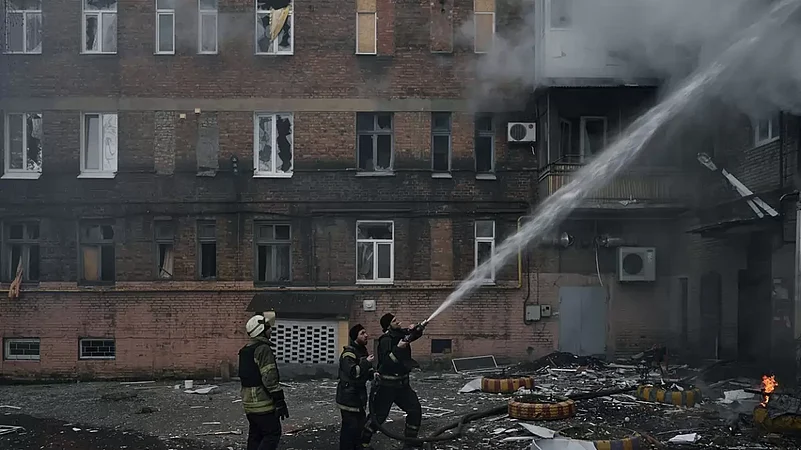Russia and Ukraine relations have seen a tumultuous array of disturbances and escalations and their common past dates back to at least the late 1700s when the territory — now called Ukraine— became part of the Russian empire after periods of rule under the Mongols, the Poles, and Lithuanians. However, Ukraine declared its independence in 1918, one year after the communist revolution in Russia, but the Red Army eventually took most of it in 1921, turning Ukraine into a republic inside the Soviet Union.
When the harsh and repressive policies of the USSR penalised farmers in the republic who defied collectivist orders, it culminated in a famine called Holodomor. Holodomor— a man-made disaster that is believed to have killed 7 million people there— intensified the Ukrainians' sense of national identity in the 1930s, and with the collapse and the disintegration of the Soviet Union in 1991, Ukraine reclaimed its independence.
Advertisement
The bilateral relations between the successor states of the erstwhile USSR have seen periods of ties, tensions, and outright hostility since 1991 when the Soviet Union disintegrated into 15 independent countries. Ukraine's policy at the beginning of the 1990s was dictated by desires to protect its independence and sovereignty, and it wanted balanced cooperation with the European Union (EU), and other powerful countries, including Russia. Post the disintegration of the USSR, the EU, US and Russia have all held different ambitions and views about Eastern Europe’s future. Russia wanted to have a sphere of influence, EU wanted a hegemonic and unified European neighbourhood and America, besides flexing its muscle to Russia, wanted to be a key player in maintaining a Euro-Atlantic community.
Advertisement
The Ukraine crisis, which has its roots in the post-cold war world, escalated in the winter of 2013-14 after Viktor Yanukovych, the then-Ukrainian President, failed to sign the European Union–Ukraine Association Agreement in November giving rise to Euromaidan— a wave of pro-EU demonstrations— across Ukraine. In a bid to curtail Ukraine’s European ambition, Russia wanted to delegitimise the pro-EU leadership to perpetuate its narrative that Ukraine naturally leans towards Russia. However, after a string of events, Yanukovuch was forced to let go of his presidency.
The protests grew and despite the attempts of Russia and the EU, things went worse in the region. Ultimately Yanukovych fled the country and a new, pro-EU provisional government in Kyiv was formed in which a huge role was played by the protesters. Arseniy Yatsenyuk was appointed as the head of a caretaker government until new elections could be held, and the new government was recognised internationally, especially by Russia’s archrival the US. It was a big blow to Russia, and it continued to maintain that the new caretaker government was illegitimate and all the events were machinated to carry out a coup d'état and that the caretaker government was illegitimate. Russia would later use this argument to justify its military incursions into Ukrainian territory, in a bid to “protect Russians and Russian speakers” that were deemed under existential threat.
After Yanukovych fled, a string of widespread pro-Russian demonstrations also sprang up, and thinking of it as an opportune moment Vladimir Putin started to work on “returning Crimea to Russia". On 27 February, Russian troops captured strategic sites across Crimea and installed the pro-Russian Aksyonov government there. Crimea was formally incorporated into Russia on 18 March 2014. In 2014 Russian-backed paramilitaries also captured a part of the Donbas region of south-eastern Ukraine. The region consists of Luhansk and Donetsk. The regions became somewhat autonomous following the Minsk agreements.
Although many believe that the Ukrainian invasion of 2022 was a Russian flex, some political observers see it as Russia’s response to NATO’s provocation and Ukraine’s unending ambitions to cobble with the EU.
Advertisement
“That enduring truth has been demonstrated by Russia’s actions in the Ukraine which, to a great extent, are the culmination of the numerous humiliations that the West, under American instigation, has inflicted on Russia’s rulers and the country as a whole over the past 30 years,” Michael Brenner
Putin, after claiming Luhansk and Donestk were being threatened by the neonazi forces of Ukraine, recognized their independence from Ukraine on February 21. The next day Russian troops entered both territories. Putin claimed that military action was necessary to stop Ukrainian attacks on the two breakaway regions of Donetsk and Lugansk.
Advertisement
The Russian invasion of Ukraine began On February 24 after Russia launched a full-scale invasion of Ukraine from Belarus to the north, the Russian-annexed Crimea Peninsula to the south, and its own territory to the east. Putin however announced it as a special military operation aiming for the "demilitarisation" and "denazification" of Ukraine.
A barrage of U.S. and EU sanctions could not deter Putin’s full-blown invasion of Ukraine. The war has since not only killed thousands, and displaced millions, but it has sent shockwaves and ripple effects across the globe, affecting political stability and economy in the regions from South Asia to Britain.




















